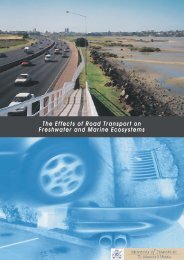Auckland City Centre Rail Link - Business Case Review - Ministry of ...
Auckland City Centre Rail Link - Business Case Review - Ministry of ...
Auckland City Centre Rail Link - Business Case Review - Ministry of ...
You also want an ePaper? Increase the reach of your titles
YUMPU automatically turns print PDFs into web optimized ePapers that Google loves.
<strong>Auckland</strong> <strong>City</strong> <strong>Centre</strong> <strong>Rail</strong> <strong>Link</strong> <strong>Business</strong> <strong>Case</strong> <strong>Review</strong> | May 2011<br />
Growth in morning peak rail patronage has also been strong. In 2010, morning peak<br />
patronage was around 9,500, which is more than two and a half times the figure <strong>of</strong><br />
3,751, in 2003.<br />
Investment to electrify and upgrade the rail network is expected to have a significant<br />
effect on patronage. The modelling forecasts used as a base case for this review<br />
suggest annual patronage <strong>of</strong> 21 million in 2016 (or 19,000 trips in the morning peak)<br />
without the CCRL. Meeting these modelled forecasts will require a doubling <strong>of</strong><br />
patronage from 2010 levels, which may be challenging despite the benefits <strong>of</strong><br />
electrification.<br />
Much <strong>of</strong> the future patronage growth forecast for the rail network comes from areas<br />
where significant intensified residential land use in growth nodes has been assumed<br />
in the model. Future rail patronage growth, including from the electrified do minimum,<br />
is therefore likely to rely, in part, on the realization <strong>of</strong> these land use assumptions.<br />
1.2 Forecast patronage growth as a result <strong>of</strong> the CCRL<br />
1.2.1 <strong>Business</strong> <strong>Case</strong> approach<br />
The <strong>Business</strong> <strong>Case</strong> used two approaches to estimate patronage effects and<br />
transport benefits resulting from the project. Two ‗strategic scenarios‘, which did not<br />
use modelling inputs, were compared to form the basis for the trip estimates used in<br />
the report.<br />
Using the strategic scenarios approach, the <strong>Business</strong> <strong>Case</strong> estimated that there<br />
would be an additional 48,000 morning peak trips into the CBD in 2041 and that the<br />
CCRL would provide for 17,000 (35 percent) <strong>of</strong> these trips.<br />
The <strong>Business</strong> <strong>Case</strong> used <strong>Auckland</strong> Public Transport (APT) model outputs as a basis<br />
for its economic evaluation. Inputs to the APT modelling, such as land use<br />
assumptions and project assumptions, were generally consistent with the 2010<br />
<strong>Auckland</strong> Regional Land Transport Strategy (ARLTS). However, two adjustments<br />
were made where 2010 ARLTS assumptions were considered unrealistic by the<br />
<strong>Business</strong> <strong>Case</strong> consultants. Higher congestion inputs were used, consistent with<br />
results for modelling <strong>of</strong> the 2005 ARLTS, and a higher CBD parking change <strong>of</strong> $30<br />
per day (in 2006 values) was applied to reflect the scarcity <strong>of</strong> parking in an intensely<br />
developed CBD.<br />
The APT model does not reflect the impact <strong>of</strong> capacity constraints on rail or other<br />
modes. To address this issue, the <strong>Business</strong> <strong>Case</strong> assumed that all rail patronage<br />
growth ceased in 2024 in the do minimum scenario. This was based on the expected<br />
effect <strong>of</strong> constraints on rail services imposed by the configuration <strong>of</strong> the Britomart<br />
station, and the limited walking catchment <strong>of</strong> Britomart on the northern periphery <strong>of</strong><br />
the CBD.<br />
1.2.2 <strong>Review</strong> approach<br />
Having assessed the assumptions in the <strong>Business</strong> <strong>Case</strong>, all agencies involved in the<br />
<strong>Review</strong> agreed to use a revised set <strong>of</strong> input assumptions consistent with the 2010<br />
ARLTS, as a base case for transport modelling <strong>of</strong> the do minimum and the project.<br />
The key changes were to use parking change (at $16 per day in 2006 values) and<br />
congestion assumptions from the modelling <strong>of</strong> the 2010 ARLTS.<br />
While central government agencies have concerns over several aspects <strong>of</strong> the 2010<br />
ARLTS, assumptions from this strategy were used to ensure consistency with other<br />
appraisals and overall regional policy. On balance, central government agencies<br />
16
















